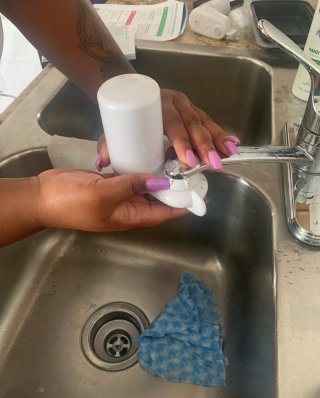Understanding Lead Pipes and Water Filters: Supporting Communities in Reducing Lead Exposure
Developing resources to help community members properly use and maintain water filters

Lead pipes were widely used in water systems throughout the 20th century, especially in cities in the Rust Belt. As public health research advanced, it became clear that lead in drinking water poses serious health risks, particularly for young children. In response, the United States banned lead pipes through an amendment to the Safe Drinking Water Act in 1986. Despite this, many communities still face challenges with aging infrastructure, where lead pipes remain in some systems.
While many communities are working to identify and replace lead pipes, lead in drinking water continues to be a concern for many households. Following water crises in Flint and Benton Harbor, Michigan, EPA researchers recognized a need for more support in installing and maintaining water filters to reduce lead exposure. Water filters offer a practical and immediate solution for protecting households from lead in drinking water.
Research Collaboration
To understand what support is needed for effective water filter use and to improve educational materials, EPA risk communication staff, scientists, and engineers partnered with the Lab at the Office of Personnel Management (OPM) and The Junction Coalition, a community organization in Toledo, Ohio. This collaboration aimed to address knowledge gaps and provide comprehensive resources to help community members properly use and maintain water filters.
The project focused on several key questions to identify the best ways to support effective water filter use:
- What support do individuals and communities need to effectively use water filters?
- What are the limitations of existing educational materials on lead and water filters?
- How can a partnership approach improve the design and effectiveness of educational content?
Community-Driven Feedback
The research team engaged leaders from state, county, and local governments, as well as community organizations focused on addressing lead exposure. They gathered and refined feedback on prototype educational materials based on input from these stakeholders.
In collaboration with The Junction Coalition, the team next developed a risk communication approach that included interviews and a community meeting with residents of the Junction neighborhood in Toledo. The Junction Coalition helped recruit participants and hosted the meeting, allowing researchers to engage directly with community members and gather valuable insights.

Key Findings
Through this research process, the research team identified some key findings:
- Layered Influences on Drinking Water Decisions: Decisions about drinking water are influenced by individual choices, local water quality issues, household dynamics, and cultural factors.
- The Journey of Effective Filter Use: Effective use of water filters involves a series of steps: purchasing the right filter, setting it up correctly, learning how to use it, and maintaining it over time. Understanding this journey is essential for supporting long-term, sustainable filter use in households.
Toolkit and Water Filter Education Handouts
The research team developed a water filter toolkit with educational materials based on community feedback and lessons learned through this partnership. The findings from this collaboration will guide future efforts to support households in effectively using water filters and reducing lead exposure.
- A toolkit for organizations supporting effective water filter education
- Water filter education handouts for community members
- Customizable handouts on water filter education that can be used by organizations to adapt to the needs of their community members
Related Resources
More Information on Lead
- Basic Information about Lead in Drinking Water
- Consumer Tool for Identifying Point-of-Use and Pitcher Filters Certified to Reduce Lead in Drinking Water (pdf)
Science Matters Stories
- Scaling Back: EPA Researchers Help Communities Protect Drinking Water Systems from Lead
- EPA Researchers Help Water Systems Keep Lead out of Drinking Water
